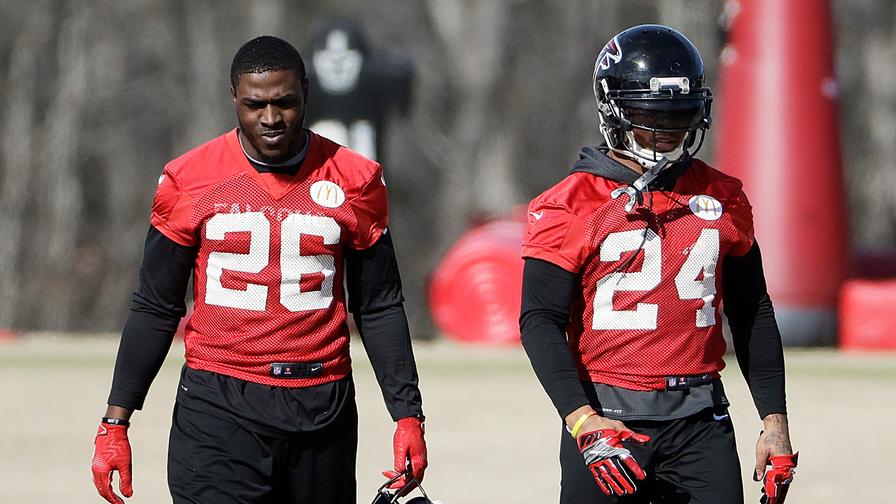Fantasy Football: There's No Reason to Worry About Devonta Freeman

In 2015, Devonta Freeman was the highest scoring fantasy back with more than 1,600 yards from scrimmage and 14 touchdowns. Those numbers have dropped in each of his two following seasons, although Freeman's year-end totals have still been pretty darn good.
Is Tevin Coleman the cause of Freeman's falling numbers, and is Coleman's presence a reason to fade Freeman this season?
Our One True God: Volume
It’s important to know why Freeman is such a high-scoring fantasy back before we can say how much Coleman hurts him.
First, Freeman is typically seeing more touches per game than most other players. In the past three years combined, Freeman is one of just four guys to place in the top-10 of carries and running back targets (with the others being Le'Veon Bell, LeSean McCoy and Melvin Gordon).
This speaks to both his usage and durability as he’s missed only three games in as many seasons at one of the most injury-riddled positions in football.
Fantasy is, at its core, an opportunity-based game, and Freeman has been getting as much raw volume as just about anyone in football.
It's not just any kind of volume, either, as Freeman also gets the best kind of volume: red-zone touches.
According to Pro Football Reference, Freeman has been in the top-10 in red zone carries, attempts inside the 10-yard line, and rushes inside the 5-yard line in each of the last three year. He also ranked third or better in red-zone targets in both 2015 and 2016 while finishing 13th in red-zone looks last season despite missing two games.
Whether it’s rushing or receiving, Freeman is getting an enormous volume of high-value touches. But does Coleman cut in to this?
The Coleman Effect
Over the last three years, when Coleman was not active, Freeman saw an increase from 14.5 rush attempts to 19.0 while seeing next to no change in targets (0.13 fewer per game). Overall, Freeman’s PPR fantasy points are boosted from 16.9 to 24.7 without Coleman in the lineup (per RotoViz). Freeman is a great back to own for fantasy with Coleman present, but he's even better to have sans Coleman.
Looking at red-zone opportunity share, Coleman also cuts into Freeman’s targets and carries inside the 20. But the Falcons utilize their backs in a variety of ways.
| Market Share | Rushing Inside 20 | Rushing Inside 10 | Rushing Inside 5 | Target Inside 20 | Targets Inside 10 |
|---|---|---|---|---|---|
| Freeman | 57.4% | 58.9% | 72.1% | 16% | 9.9% |
| Coleman | 24.9% | 31.0% | 23.0% | 7.4% | 5.8% |
It's worth noting that Coleman missed five more games over these three seasons than Freeman did, but he started in two games in which Freeman was active. So while this comparison isn’t perfectly an apples-to-apples look, it does give us a realistic sample of the distribution of touches in Atlanta.
In terms of targets, Coleman sees just under half of the targets that Freeman sees, and as they move closer to the end zone, Coleman’s target share starts nearing Freeman’s.
When looking at carries, initially it appears as though Coleman might have a large effect here, as well. Inside the 20 and 10, Coleman keeps Freeman under 60% of the team’s carries. But where it really counts, inside the five, Freeman vastly out-carries Coleman.
Freeman is the go-to-guy for Atlanta in the red zone, but in front of the end zone, he might as well be the only guy.
Will This Split Hold?
Freeman's and Coleman’s efficiency, based on our Net Expected Points metric (NEP), might illuminate why the Falcons use their backs this way.
For those new to numberFire, NEP is the metric we use to track the efficiency of both teams and players, with the team side being adjusted for strength of opponent. A five-yard run on 3rd and 4 is wildly different than a five-yard run on 3rd and 8, and NEP helps account for that by tracking the expected points players add to their team's total over the course of a season. You can read more about NEP in our glossary.
Over their three years together, Freeman has recorded a better Rushing NEP per attempt mark each year, and he is the clear choice to carry the majority of their high-value and total rushes.
| Player | Rushing NEP per Carry | Target NEP per Target |
|---|---|---|
| Freeman | 0.05 | 0.18 |
| Coleman | -0.04 | 0.32 |
Their receiving efficiency is flipped. Coleman has been the more effective receiver in two of three years and is more efficient on a per-target basis.
The Falcons might not be using our models, but they can best tell how to best deploy their backs. And what they've told us -- loudly and clearly -- through the way they've deployed them is that Freeman is their dude.
In Conclusion
In 2018, the final year of Coleman’s rookie contract -- and maybe his last campaign in Atlanta -- it's safe to expect to see Coleman and Freeman deployed similarly.
Per Fantasy Football Calculator's PPR average draft position data, Freeman is going as the 11th running back off the board. Given his expected volume and scoring potential, our projections agree as we have him as our RB11, projecting Freeman for 1,035.2 rushing yards, 396.1 receiving yards, 46.5 catches and 9.54 total touchdowns.
Coleman’s presence makes a repeat of Freeman’s overall RB1 finish in 2015 fairly unlikely, but it's no reason to shy away from Freeman at his current price. He's clearly the Falcons' top back, and we should feel great about his 2018 outlook.
















